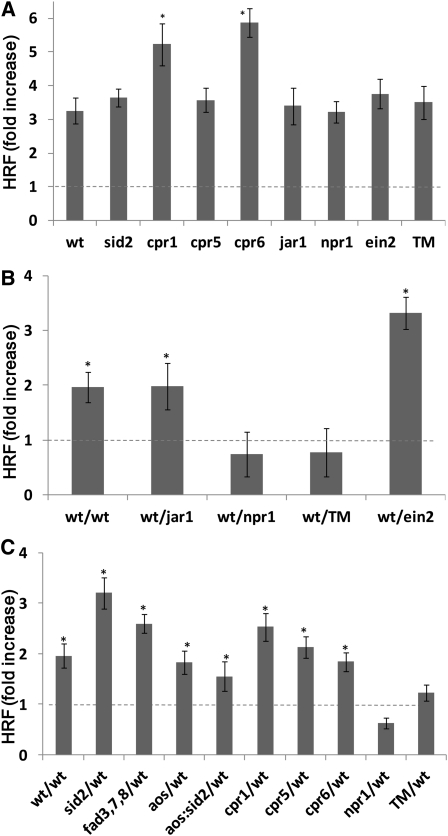Figure 4.
Changes in HRF in Hormone Signaling and Hormone Synthesis Mutants.
Three-week-old Arabidopsis wild-type (wt) plants (line #15d8) and various mutants (npr1 jar1 ein2 triple mutant [TM]) were either UV-C irradiated to test volatile emission or used as bystander. For (B) and (C), irradiated plants were immediately placed into plastic bags together with nonirradiated plants. Control plants (the wild type or mutants) were placed into sealed bags without irradiation.
(A) HRF in UV-C–irradiated wild-type and mutant plants is shown as average (±sd) fold increase over HRF in unexposed plants calculated from four independent experiments, with each experiment consisting of ~100 plants. Asterisks indicate a significant difference from control plants (P < 0.05). Dashed line refers to control, assigned a value of 1.
(B) HRF in bystander hormone signaling mutants exposed to volatiles from wild-type irradiated plants. Bars represent average HRF fold increase (compared with control) ± sd of three biological repeats, each one consisting of three pots containing 12 to 20 plants. Asterisks indicate a significant difference from control plants (P < 0.05). Dashed line refers to control, assigned a value of 1.
(C) HRF in bystander wild-type plants exposed to volatiles from irradiated hormone signaling or hormone synthesis/accumulation mutants. Bars represent average HRF fold increase (compared with control) ± sd of three biological repeats, each one consisting of three pots containing 12 to 20 plants. Asterisks indicate a significant difference from control plants (P < 0.05). Dashed line refers to control, assigned a value of 1.

